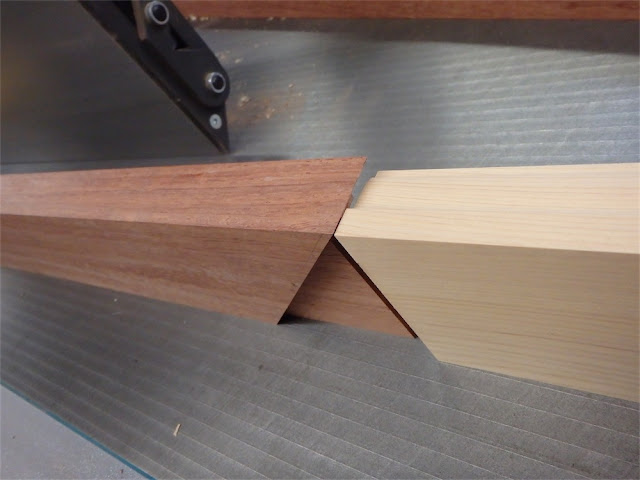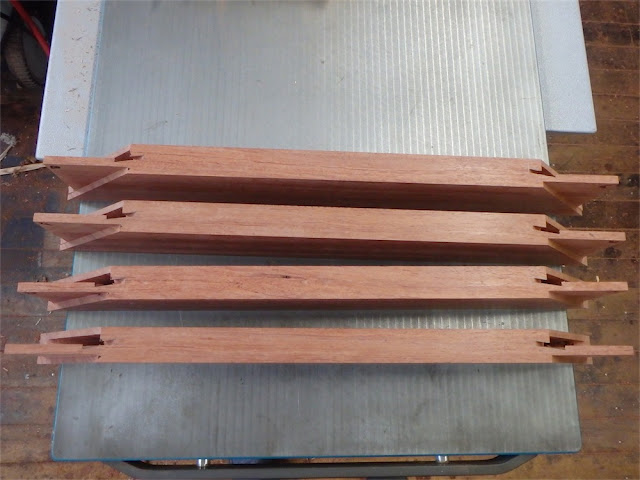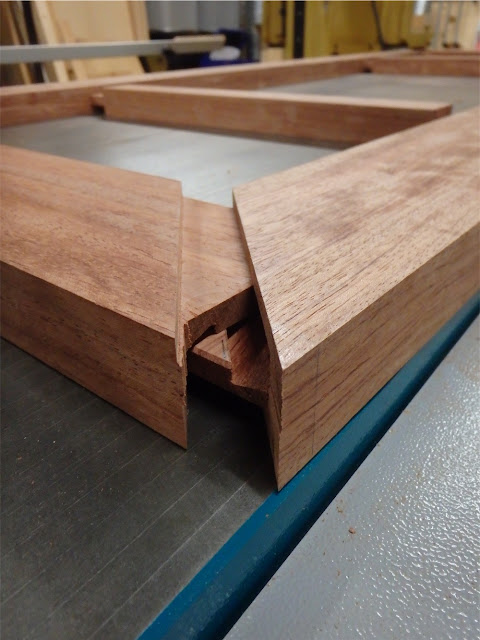Post 21 in a continuing series….
—————-
Starting out today with some of the following pieces staring me in the face:
After the joinery is completed on the cornice pieces, I will profile them. To that end, I spent the first while working to set up my shaper with a very nice Aigner accessory I happen to have, the ‘dickenanschlag’ or back fence:
Amusingly, Google Translate says 'dickenanschlag’ is a dick stop. Hah!
Also aiding in this process, though concealed largely behind the feeder, is another Aigner product, the 'druckbacken’. This is a device with a pair of acrylic plastic 'springs’ which surround the cutter head and which push the wood away from the main fence and into the back fence. Of course, the feeder is also aligned so as to drift the stock over to and along the back fence.
The back fence allows a profile to be conveniently shaped on the edge of a board without worry that any offsets from the front face may occur along the fence, causing an uneven molded surface.
Here, I’ve put a piece of scrap material through to check the cutting depth on the edge of the board, after having made previous passes with other test boards to get the cutter dialed in to the correct height:
After this first pass, you can see the ink that is remaining on a portion of the edge, indicating that the cutter hasn’t totally cleaned the face off:
I planed the sticks themselves so that they are only about 0.0250" over finished dimension, so I had only a sukoshi of material to remove and therefore needed to approach the milling carefully.
The second pass, after a slight adjustment of the back fence distance was performed, molded the entire face:
The knives for shaping this profile were designed by me and made by CGG Schmidt. These HSS knives are of the corrugated type and fit into a 2-knife holder.
At this juncture, the edge is fully molded however the dimension overall is slightly fat of the target value of 3.375":
The molded face was cut cleanly, though as usual the camera work failed to capture the surface sheen:
Another slight adjustment of the back fence and pass through of the piece revealed that I was within a hair of target dimension, so that’s where I decided that the machine was set suitably:
Aiding in the precise setting of the Aigner back fence, which is very sturdily made and will not deflect in use, is its digital depth gauge:
Here you can see the molded test piece alongside one of the cornice pieces:
I’ll save the molding work for later as I want to complete the joinery work on the cornice first. The shaper is set up and ready to go as soon as the sticks are.
Here I’m laying the cornice pieces out to see if one arrangement or another might look the best:
The other set of four in the same process:
* The wood was placed carefully and temporarily upon the jointer tables and removed shortly thereafter. No jointer infeed tables were damaged or marked in any way during any part of the temporary positioning process. (This note is for a certain regular reader -CM- who has expressed previous concerns).
Once the arrangements of the parts relative to one another were established to my satisfaction, I marked the joints so i knew what was supposed to go with what.
The cutting of the angled and tapered trenches for the shachi sen was the next step to undertake, beginning with a round of layout and on into the chisel and saw work:
These angled trenches can only really be cut by hand, given their complex shape and awkward access:
Another view:
Sharpen, then chisel, then sharpen some more, rinse and repeat:
I spent most of the day with chisels and saw, staring very intently as these joints. The staring continued through today as well:
The shorts are done:
Another view:
Another view:
Rinse and repeat…the long cornice pieces now done, including the mortises for the intermediate members:
Another view of one end:
The joints are pretty much there, though a little material will likely need to be shaved yet.
The other end:
Checking as always to see that the abutments - here with the short end cornice pieces - were close to the target dimension, @15"(381mm) shoulder to shoulder:
A preliminary assembly shows things going together just fine, with a little fettlling awaiting yet at each intersection:
Another view:
Of course, I quickly removed those pieces from the jointer table, not wanting to damage the equipment*
Here’s the other set:
A closer look at one of the corner joints partway together, main abutments not yet trimmed:
I estimate a full day of work ahead to fit those joints up.
—————–
In other news, I acquired some more bubinga, namely 4 planks at 9/4 thick, 12" wide, and 94" long:
These are all rift-sawn boards, and were milled in Africa - note the chainsaw marks:
They look to have a mottled-to-ribbon-stripe figure, and I’ll get a better idea of how they look when I give them a jointing and planing sometime down the line.
The material is the perfect grain orientation, as far as I am concerned:
In other news…
…I thought readers might want to see some of the shavings of off the cornice pieces:
More evidence that these super surfacers just don’t work very well on hardwoods, by all accounts:
Seems to get me where I need to be despite how unsuitable it is supposed to be for the task.
*Private joke for Chris M.
All for today, thanks for dropping by the Carpentry Way. Have joyful Christmas if you choose to celebrate, otherwise continue in your efforts to leap from triumph to triumph.
via Tumblr http://davidpires578.tumblr.com/post/135815875784


































No comments:
Post a Comment